Manage Budgets and Financial Plans for Facility Management
VerifiedAdded on 2023/06/06
|8
|1360
|398
AI Summary
This article discusses the importance of budgeting and financial planning in facility management. It covers topics such as cash flow projections, short term budgets/plans, and contingency planning. The article also includes relevant discussions with financial managers, controllers, supervisors, and accountants. References are provided for further reading.
Contribute Materials
Your contribution can guide someone’s learning journey. Share your
documents today.
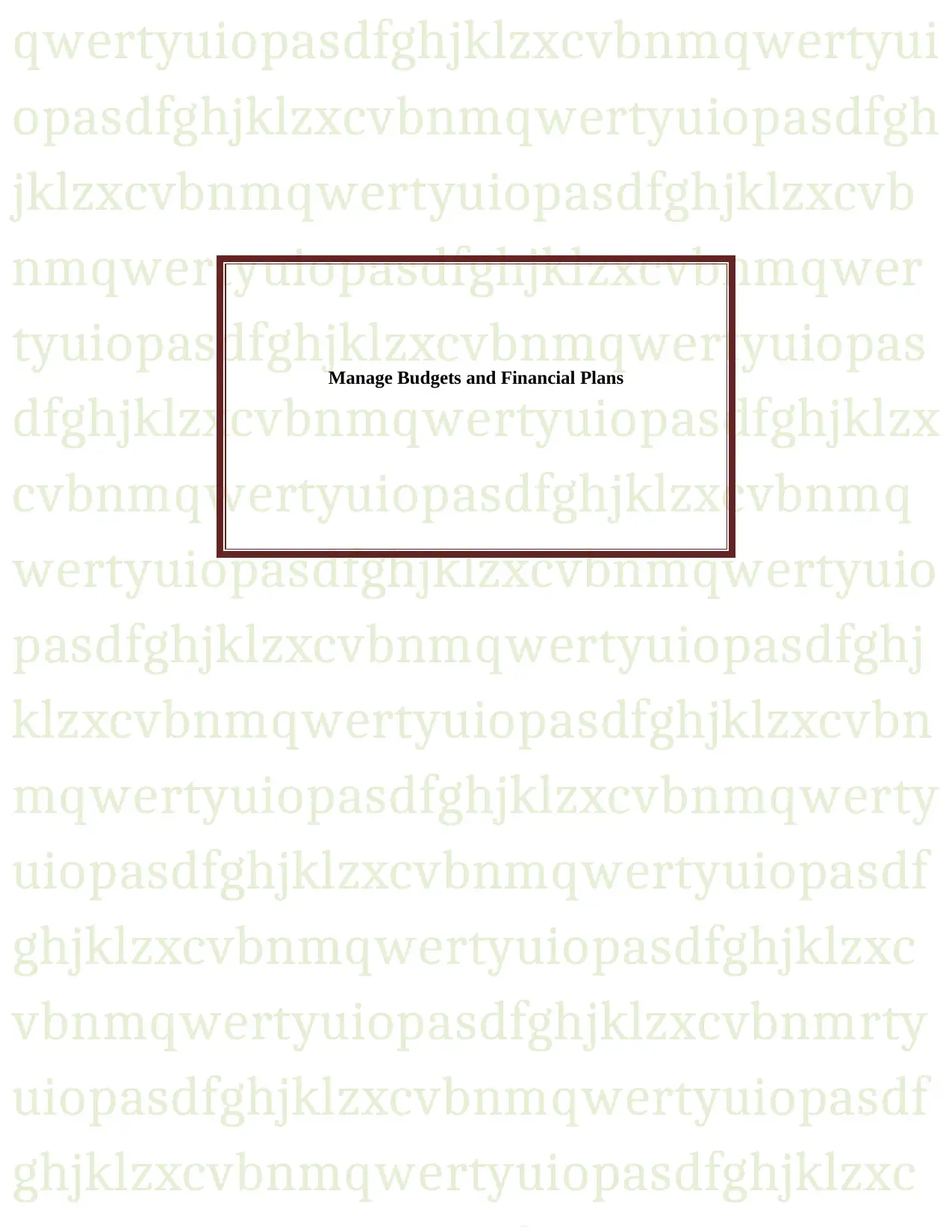
qwertyuiopasdfghjklzxcvbnmqwertyui
opasdfghjklzxcvbnmqwertyuiopasdfgh
jklzxcvbnmqwertyuiopasdfghjklzxcvb
nmqwertyuiopasdfghjklzxcvbnmqwer
tyuiopasdfghjklzxcvbnmqwertyuiopas
dfghjklzxcvbnmqwertyuiopasdfghjklzx
cvbnmqwertyuiopasdfghjklzxcvbnmq
wertyuiopasdfghjklzxcvbnmqwertyuio
pasdfghjklzxcvbnmqwertyuiopasdfghj
klzxcvbnmqwertyuiopasdfghjklzxcvbn
mqwertyuiopasdfghjklzxcvbnmqwerty
uiopasdfghjklzxcvbnmqwertyuiopasdf
ghjklzxcvbnmqwertyuiopasdfghjklzxc
vbnmqwertyuiopasdfghjklzxcvbnmrty
uiopasdfghjklzxcvbnmqwertyuiopasdf
ghjklzxcvbnmqwertyuiopasdfghjklzxc
Manage Budgets and Financial Plans
opasdfghjklzxcvbnmqwertyuiopasdfgh
jklzxcvbnmqwertyuiopasdfghjklzxcvb
nmqwertyuiopasdfghjklzxcvbnmqwer
tyuiopasdfghjklzxcvbnmqwertyuiopas
dfghjklzxcvbnmqwertyuiopasdfghjklzx
cvbnmqwertyuiopasdfghjklzxcvbnmq
wertyuiopasdfghjklzxcvbnmqwertyuio
pasdfghjklzxcvbnmqwertyuiopasdfghj
klzxcvbnmqwertyuiopasdfghjklzxcvbn
mqwertyuiopasdfghjklzxcvbnmqwerty
uiopasdfghjklzxcvbnmqwertyuiopasdf
ghjklzxcvbnmqwertyuiopasdfghjklzxc
vbnmqwertyuiopasdfghjklzxcvbnmrty
uiopasdfghjklzxcvbnmqwertyuiopasdf
ghjklzxcvbnmqwertyuiopasdfghjklzxc
Manage Budgets and Financial Plans
Secure Best Marks with AI Grader
Need help grading? Try our AI Grader for instant feedback on your assignments.
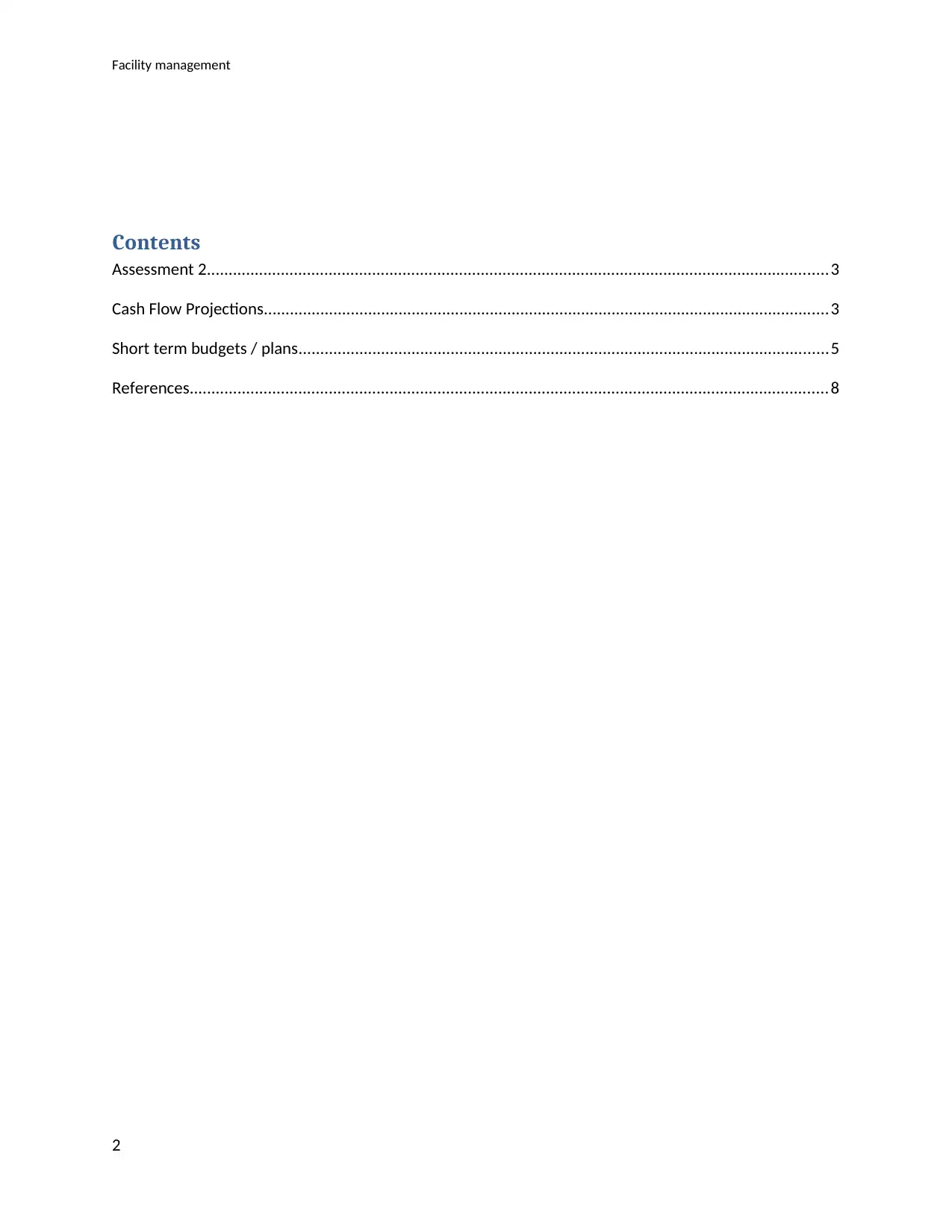
Facility management
Contents
Assessment 2...............................................................................................................................................3
Cash Flow Projections..................................................................................................................................3
Short term budgets / plans..........................................................................................................................5
References...................................................................................................................................................8
2
Contents
Assessment 2...............................................................................................................................................3
Cash Flow Projections..................................................................................................................................3
Short term budgets / plans..........................................................................................................................5
References...................................................................................................................................................8
2
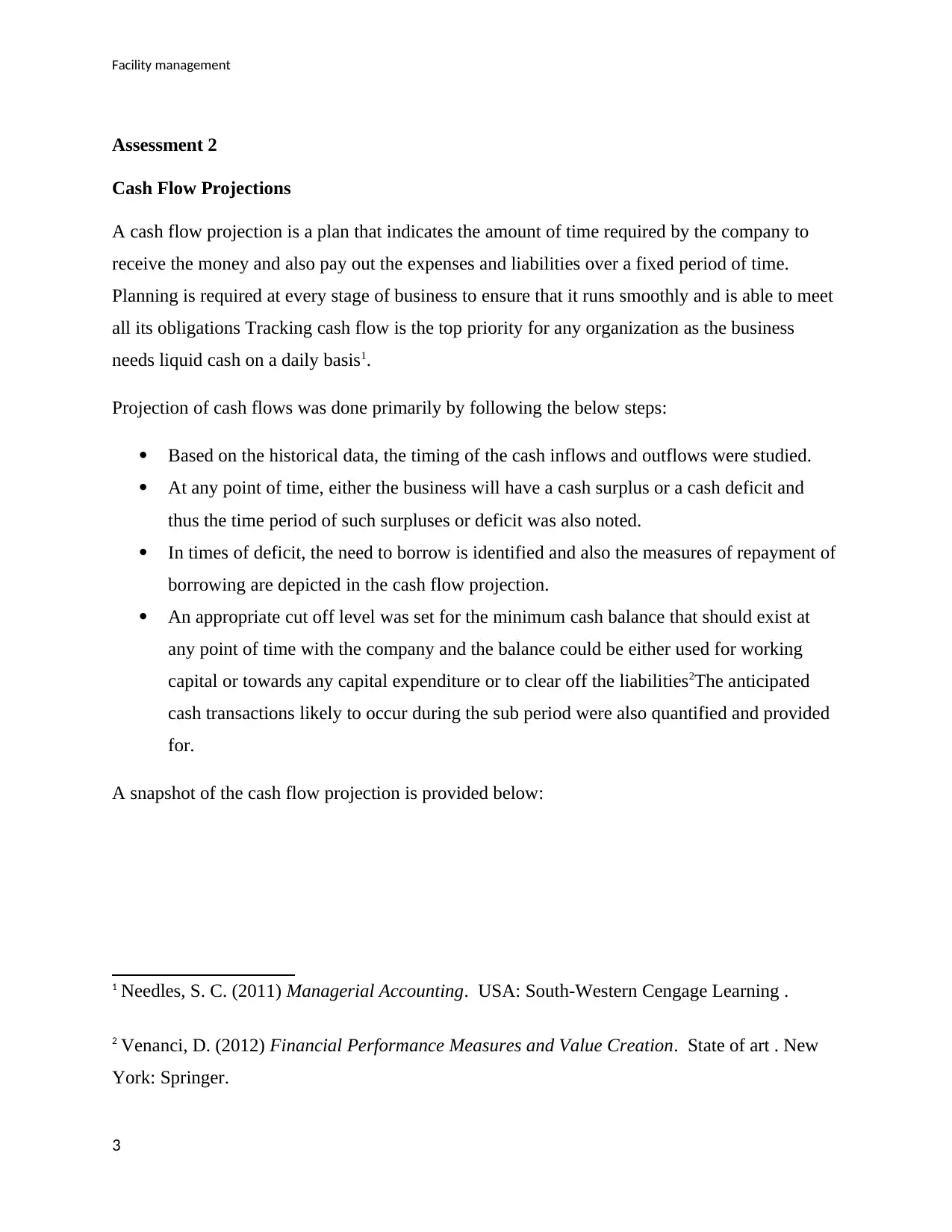
Facility management
Assessment 2
Cash Flow Projections
A cash flow projection is a plan that indicates the amount of time required by the company to
receive the money and also pay out the expenses and liabilities over a fixed period of time.
Planning is required at every stage of business to ensure that it runs smoothly and is able to meet
all its obligations Tracking cash flow is the top priority for any organization as the business
needs liquid cash on a daily basis1.
Projection of cash flows was done primarily by following the below steps:
Based on the historical data, the timing of the cash inflows and outflows were studied.
At any point of time, either the business will have a cash surplus or a cash deficit and
thus the time period of such surpluses or deficit was also noted.
In times of deficit, the need to borrow is identified and also the measures of repayment of
borrowing are depicted in the cash flow projection.
An appropriate cut off level was set for the minimum cash balance that should exist at
any point of time with the company and the balance could be either used for working
capital or towards any capital expenditure or to clear off the liabilities2The anticipated
cash transactions likely to occur during the sub period were also quantified and provided
for.
A snapshot of the cash flow projection is provided below:
1 Needles, S. C. (2011) Managerial Accounting. USA: South-Western Cengage Learning .
2 Venanci, D. (2012) Financial Performance Measures and Value Creation. State of art . New
York: Springer.
3
Assessment 2
Cash Flow Projections
A cash flow projection is a plan that indicates the amount of time required by the company to
receive the money and also pay out the expenses and liabilities over a fixed period of time.
Planning is required at every stage of business to ensure that it runs smoothly and is able to meet
all its obligations Tracking cash flow is the top priority for any organization as the business
needs liquid cash on a daily basis1.
Projection of cash flows was done primarily by following the below steps:
Based on the historical data, the timing of the cash inflows and outflows were studied.
At any point of time, either the business will have a cash surplus or a cash deficit and
thus the time period of such surpluses or deficit was also noted.
In times of deficit, the need to borrow is identified and also the measures of repayment of
borrowing are depicted in the cash flow projection.
An appropriate cut off level was set for the minimum cash balance that should exist at
any point of time with the company and the balance could be either used for working
capital or towards any capital expenditure or to clear off the liabilities2The anticipated
cash transactions likely to occur during the sub period were also quantified and provided
for.
A snapshot of the cash flow projection is provided below:
1 Needles, S. C. (2011) Managerial Accounting. USA: South-Western Cengage Learning .
2 Venanci, D. (2012) Financial Performance Measures and Value Creation. State of art . New
York: Springer.
3
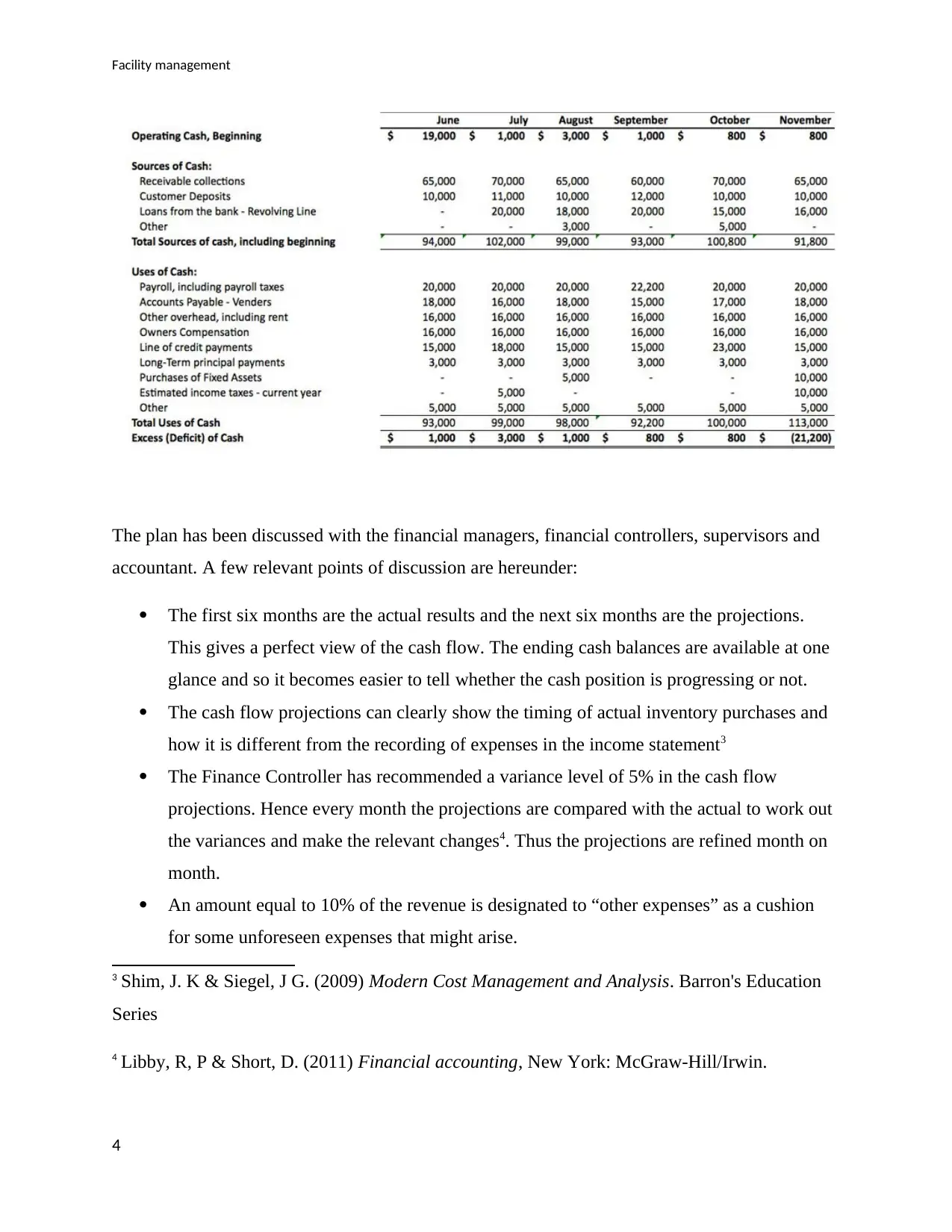
Facility management
The plan has been discussed with the financial managers, financial controllers, supervisors and
accountant. A few relevant points of discussion are hereunder:
The first six months are the actual results and the next six months are the projections.
This gives a perfect view of the cash flow. The ending cash balances are available at one
glance and so it becomes easier to tell whether the cash position is progressing or not.
The cash flow projections can clearly show the timing of actual inventory purchases and
how it is different from the recording of expenses in the income statement3
The Finance Controller has recommended a variance level of 5% in the cash flow
projections. Hence every month the projections are compared with the actual to work out
the variances and make the relevant changes4. Thus the projections are refined month on
month.
An amount equal to 10% of the revenue is designated to “other expenses” as a cushion
for some unforeseen expenses that might arise.
3 Shim, J. K & Siegel, J G. (2009) Modern Cost Management and Analysis. Barron's Education
Series
4 Libby, R, P & Short, D. (2011) Financial accounting, New York: McGraw-Hill/Irwin.
4
The plan has been discussed with the financial managers, financial controllers, supervisors and
accountant. A few relevant points of discussion are hereunder:
The first six months are the actual results and the next six months are the projections.
This gives a perfect view of the cash flow. The ending cash balances are available at one
glance and so it becomes easier to tell whether the cash position is progressing or not.
The cash flow projections can clearly show the timing of actual inventory purchases and
how it is different from the recording of expenses in the income statement3
The Finance Controller has recommended a variance level of 5% in the cash flow
projections. Hence every month the projections are compared with the actual to work out
the variances and make the relevant changes4. Thus the projections are refined month on
month.
An amount equal to 10% of the revenue is designated to “other expenses” as a cushion
for some unforeseen expenses that might arise.
3 Shim, J. K & Siegel, J G. (2009) Modern Cost Management and Analysis. Barron's Education
Series
4 Libby, R, P & Short, D. (2011) Financial accounting, New York: McGraw-Hill/Irwin.
4
Secure Best Marks with AI Grader
Need help grading? Try our AI Grader for instant feedback on your assignments.
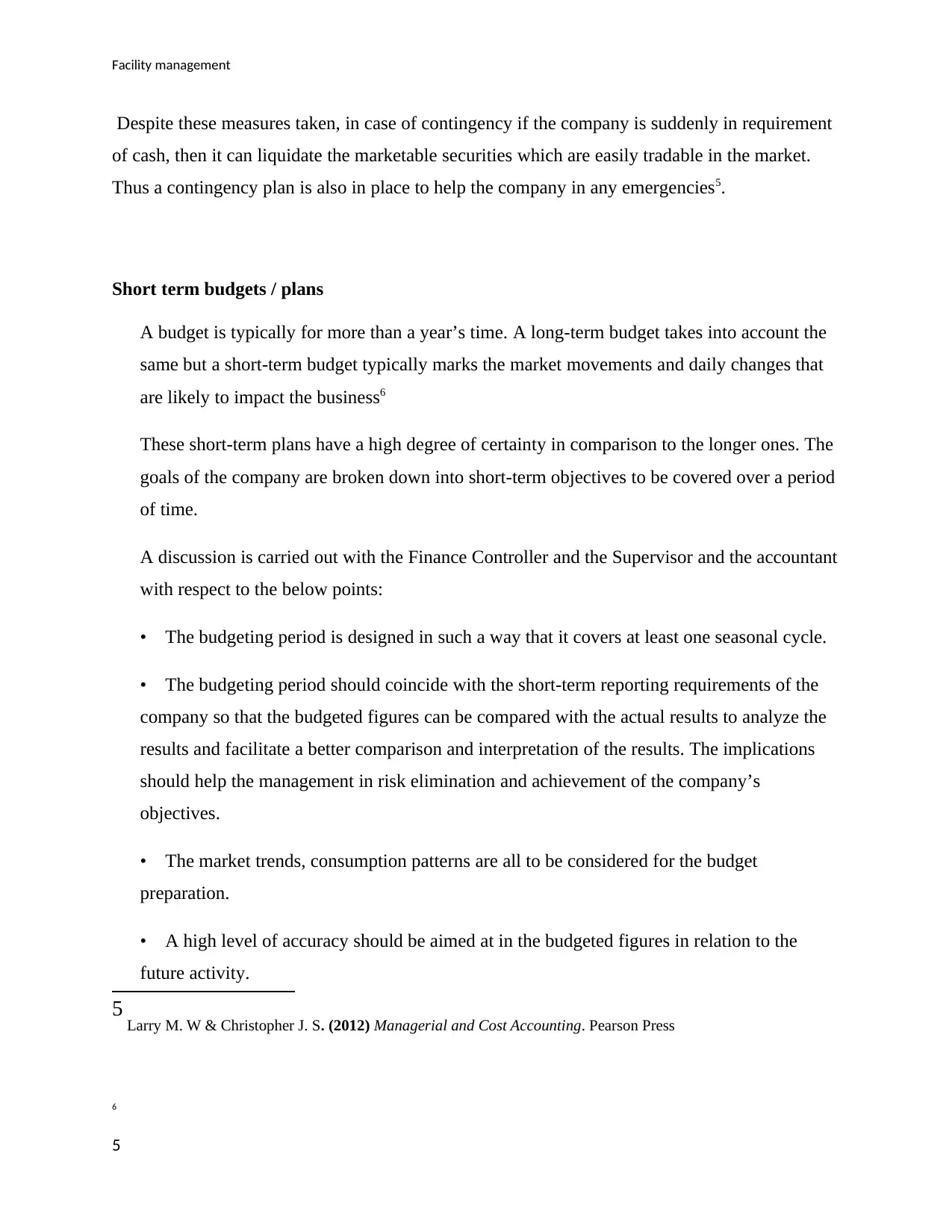
Facility management
Despite these measures taken, in case of contingency if the company is suddenly in requirement
of cash, then it can liquidate the marketable securities which are easily tradable in the market.
Thus a contingency plan is also in place to help the company in any emergencies5.
Short term budgets / plans
A budget is typically for more than a year’s time. A long-term budget takes into account the
same but a short-term budget typically marks the market movements and daily changes that
are likely to impact the business6
These short-term plans have a high degree of certainty in comparison to the longer ones. The
goals of the company are broken down into short-term objectives to be covered over a period
of time.
A discussion is carried out with the Finance Controller and the Supervisor and the accountant
with respect to the below points:
• The budgeting period is designed in such a way that it covers at least one seasonal cycle.
• The budgeting period should coincide with the short-term reporting requirements of the
company so that the budgeted figures can be compared with the actual results to analyze the
results and facilitate a better comparison and interpretation of the results. The implications
should help the management in risk elimination and achievement of the company’s
objectives.
• The market trends, consumption patterns are all to be considered for the budget
preparation.
• A high level of accuracy should be aimed at in the budgeted figures in relation to the
future activity.
5 Larry M. W & Christopher J. S. (2012) Managerial and Cost Accounting. Pearson Press
6
5
Despite these measures taken, in case of contingency if the company is suddenly in requirement
of cash, then it can liquidate the marketable securities which are easily tradable in the market.
Thus a contingency plan is also in place to help the company in any emergencies5.
Short term budgets / plans
A budget is typically for more than a year’s time. A long-term budget takes into account the
same but a short-term budget typically marks the market movements and daily changes that
are likely to impact the business6
These short-term plans have a high degree of certainty in comparison to the longer ones. The
goals of the company are broken down into short-term objectives to be covered over a period
of time.
A discussion is carried out with the Finance Controller and the Supervisor and the accountant
with respect to the below points:
• The budgeting period is designed in such a way that it covers at least one seasonal cycle.
• The budgeting period should coincide with the short-term reporting requirements of the
company so that the budgeted figures can be compared with the actual results to analyze the
results and facilitate a better comparison and interpretation of the results. The implications
should help the management in risk elimination and achievement of the company’s
objectives.
• The market trends, consumption patterns are all to be considered for the budget
preparation.
• A high level of accuracy should be aimed at in the budgeted figures in relation to the
future activity.
5 Larry M. W & Christopher J. S. (2012) Managerial and Cost Accounting. Pearson Press
6
5
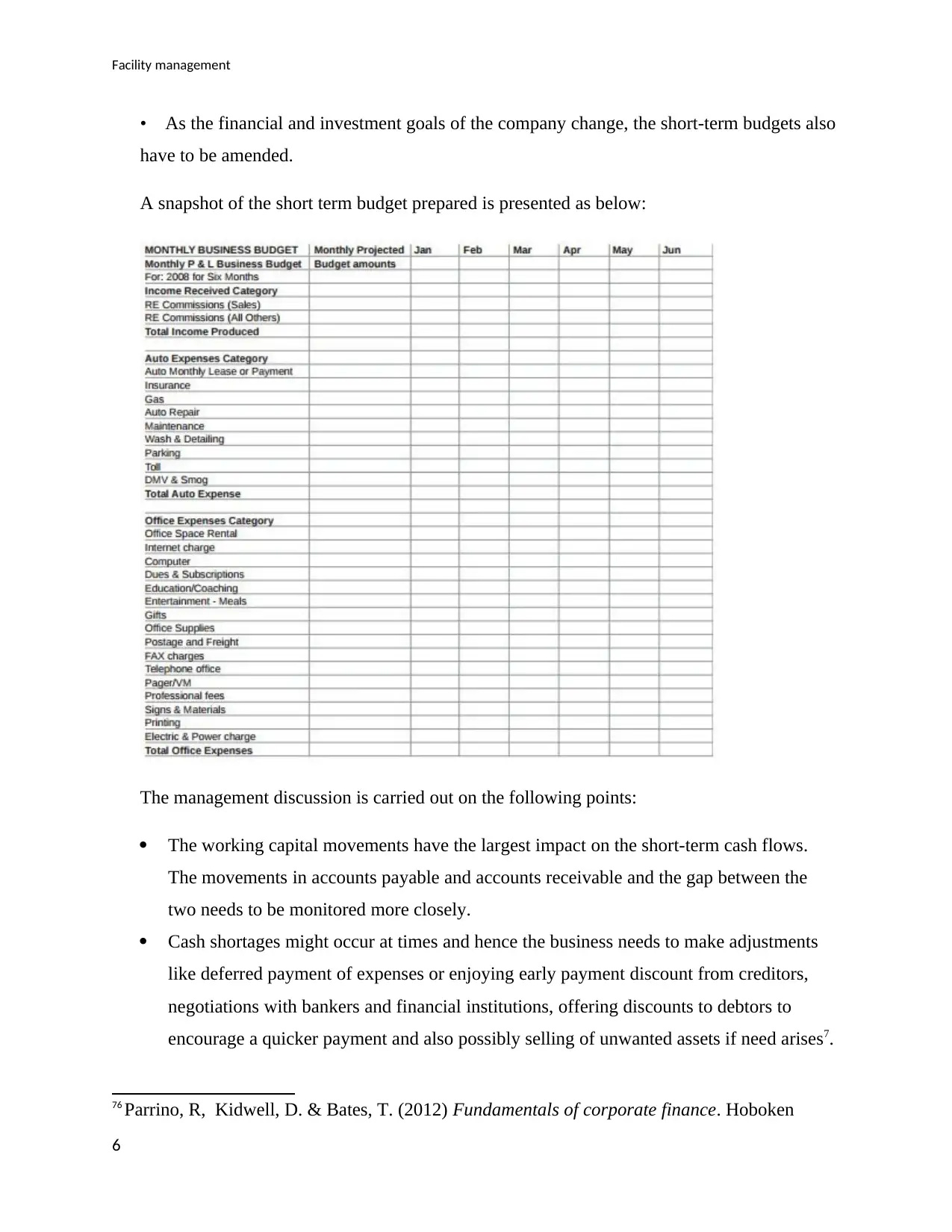
Facility management
• As the financial and investment goals of the company change, the short-term budgets also
have to be amended.
A snapshot of the short term budget prepared is presented as below:
The management discussion is carried out on the following points:
The working capital movements have the largest impact on the short-term cash flows.
The movements in accounts payable and accounts receivable and the gap between the
two needs to be monitored more closely.
Cash shortages might occur at times and hence the business needs to make adjustments
like deferred payment of expenses or enjoying early payment discount from creditors,
negotiations with bankers and financial institutions, offering discounts to debtors to
encourage a quicker payment and also possibly selling of unwanted assets if need arises7.
76 Parrino, R, Kidwell, D. & Bates, T. (2012) Fundamentals of corporate finance. Hoboken
6
• As the financial and investment goals of the company change, the short-term budgets also
have to be amended.
A snapshot of the short term budget prepared is presented as below:
The management discussion is carried out on the following points:
The working capital movements have the largest impact on the short-term cash flows.
The movements in accounts payable and accounts receivable and the gap between the
two needs to be monitored more closely.
Cash shortages might occur at times and hence the business needs to make adjustments
like deferred payment of expenses or enjoying early payment discount from creditors,
negotiations with bankers and financial institutions, offering discounts to debtors to
encourage a quicker payment and also possibly selling of unwanted assets if need arises7.
76 Parrino, R, Kidwell, D. & Bates, T. (2012) Fundamentals of corporate finance. Hoboken
6
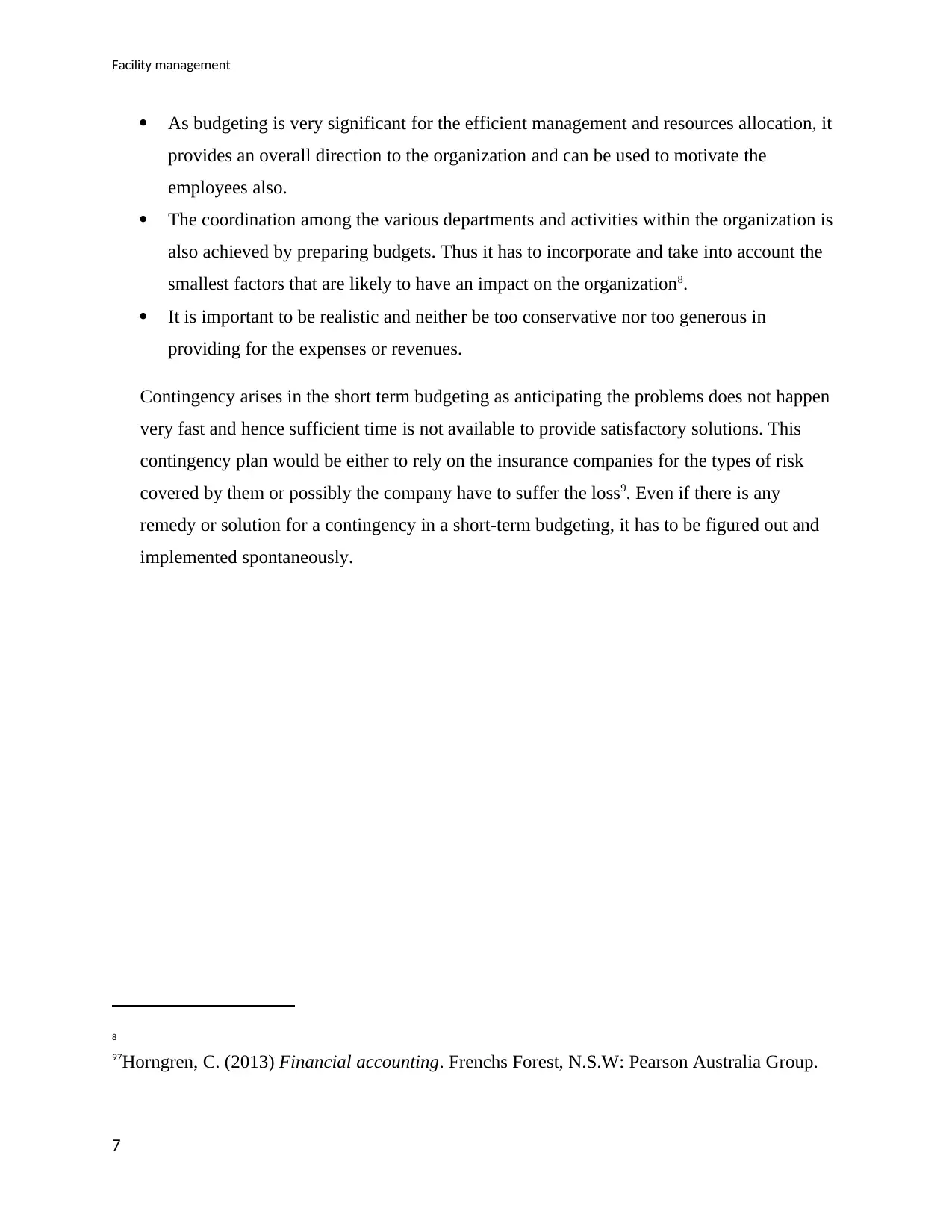
Facility management
As budgeting is very significant for the efficient management and resources allocation, it
provides an overall direction to the organization and can be used to motivate the
employees also.
The coordination among the various departments and activities within the organization is
also achieved by preparing budgets. Thus it has to incorporate and take into account the
smallest factors that are likely to have an impact on the organization8.
It is important to be realistic and neither be too conservative nor too generous in
providing for the expenses or revenues.
Contingency arises in the short term budgeting as anticipating the problems does not happen
very fast and hence sufficient time is not available to provide satisfactory solutions. This
contingency plan would be either to rely on the insurance companies for the types of risk
covered by them or possibly the company have to suffer the loss9. Even if there is any
remedy or solution for a contingency in a short-term budgeting, it has to be figured out and
implemented spontaneously.
8
97Horngren, C. (2013) Financial accounting. Frenchs Forest, N.S.W: Pearson Australia Group.
7
As budgeting is very significant for the efficient management and resources allocation, it
provides an overall direction to the organization and can be used to motivate the
employees also.
The coordination among the various departments and activities within the organization is
also achieved by preparing budgets. Thus it has to incorporate and take into account the
smallest factors that are likely to have an impact on the organization8.
It is important to be realistic and neither be too conservative nor too generous in
providing for the expenses or revenues.
Contingency arises in the short term budgeting as anticipating the problems does not happen
very fast and hence sufficient time is not available to provide satisfactory solutions. This
contingency plan would be either to rely on the insurance companies for the types of risk
covered by them or possibly the company have to suffer the loss9. Even if there is any
remedy or solution for a contingency in a short-term budgeting, it has to be figured out and
implemented spontaneously.
8
97Horngren, C. (2013) Financial accounting. Frenchs Forest, N.S.W: Pearson Australia Group.
7
Paraphrase This Document
Need a fresh take? Get an instant paraphrase of this document with our AI Paraphraser
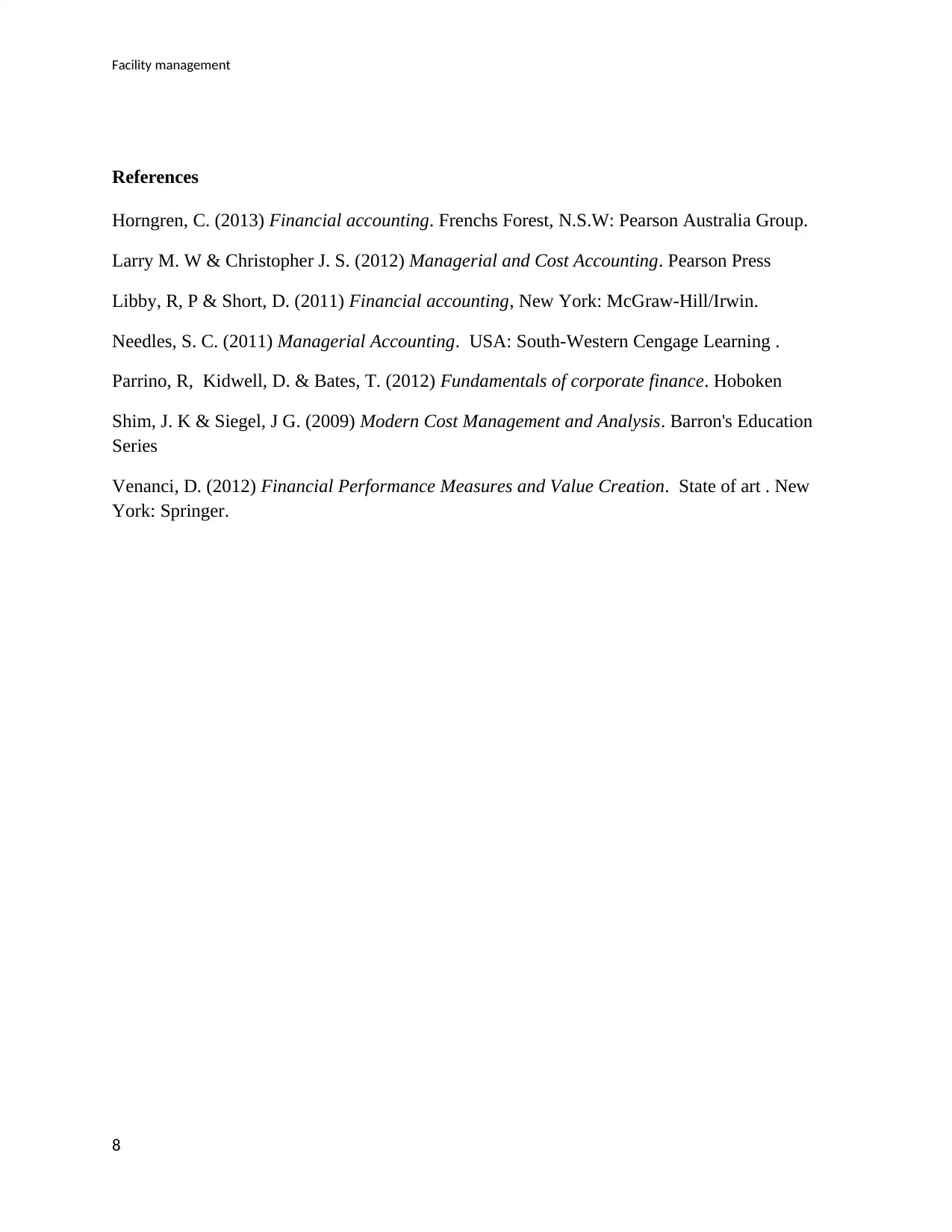
Facility management
References
Horngren, C. (2013) Financial accounting. Frenchs Forest, N.S.W: Pearson Australia Group.
Larry M. W & Christopher J. S. (2012) Managerial and Cost Accounting. Pearson Press
Libby, R, P & Short, D. (2011) Financial accounting, New York: McGraw-Hill/Irwin.
Needles, S. C. (2011) Managerial Accounting. USA: South-Western Cengage Learning .
Parrino, R, Kidwell, D. & Bates, T. (2012) Fundamentals of corporate finance. Hoboken
Shim, J. K & Siegel, J G. (2009) Modern Cost Management and Analysis. Barron's Education
Series
Venanci, D. (2012) Financial Performance Measures and Value Creation. State of art . New
York: Springer.
8
References
Horngren, C. (2013) Financial accounting. Frenchs Forest, N.S.W: Pearson Australia Group.
Larry M. W & Christopher J. S. (2012) Managerial and Cost Accounting. Pearson Press
Libby, R, P & Short, D. (2011) Financial accounting, New York: McGraw-Hill/Irwin.
Needles, S. C. (2011) Managerial Accounting. USA: South-Western Cengage Learning .
Parrino, R, Kidwell, D. & Bates, T. (2012) Fundamentals of corporate finance. Hoboken
Shim, J. K & Siegel, J G. (2009) Modern Cost Management and Analysis. Barron's Education
Series
Venanci, D. (2012) Financial Performance Measures and Value Creation. State of art . New
York: Springer.
8
1 out of 8
Related Documents
Your All-in-One AI-Powered Toolkit for Academic Success.
+13062052269
info@desklib.com
Available 24*7 on WhatsApp / Email
![[object Object]](/_next/static/media/star-bottom.7253800d.svg)
Unlock your academic potential
© 2024 | Zucol Services PVT LTD | All rights reserved.





